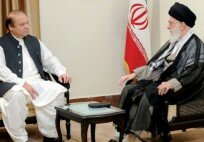By Omer Bangash –
The way forward for Pakistani films
The concept of ‘Pakistaniat’ is a multi-faceted one, and it just might be a boon for the nascent neo-Pakistani film industry. ‘Pakistaniat’ shouldn’t just be construed in nationalistic terms, but more in terms of cultural identity. Embracing unique (after all, for better or worse, there is only one Karachi in the world) local characters, stories and settings can help build a ‘brand’ of Pakistani cinema, which is essential for its medium to long term growth. It also helps in differentiating local products from the big budget ruckus that hits the theaters. Some of the most successful and anticipated releases of late seem to have embraced this idea, which is a terribly exciting proposition.
First things first, banning Indian movies in local theaters will not improve Pakistani films. It has been done before, and it has failed miserably. In fact, it can be argued that the success of Bollywood movies was a catalyst for the rebirth of Pakistani films, albeit a different kind than what were being produced before the bust.
When the distribution channels, the cinema businesses, became profitable again because of these Indian movies, it opened opportunities for local films to be made and distributed. When cinemas became profitable, they improved their service as well, newer entrants have built bigger halls, imported newer technology; the opening of multiplexes throughout the major cities of Pakistan is especially a huge plus, multiplexes which have long been stalwarts of lower budget, independent cinema. The theory being that when bigger attractions rake in the crowds for the main show, the smaller movies playing side by side get a lot of exposure through the multitudes thronging the halls.
Not to mention the increased receptiveness of multiple screen cinema owners to put up smaller budget movies in the first place. However, to really catch the eye of the reemerging Pakistani theater-going class, local films need to differentiate themselves from the array of mass-entertainment Indian movies.

‘Khuda Ke Liye’ could perhaps be the first movie classifiable as a neo-Pakistani film. Despite its many flaws, the movie was successful in bringing a middle/upper-middle class audience to watch a Pakistani film, which wasn’t very common in the past. This is not intended to be an affront to the traditional Lollywood films; many of them were more successful than ‘Khuda Ke Liye’, in sheer numbers, but they rarely attracted the interest of the educated urban elite with large disposable incomes. Hence they struggled to make progress with their budgets and production values.
Other examples like ‘Bol’, ‘Waar’, ‘Zinda Bhaag’, and even ‘Main Houn Shahid Afridi’ also fall into this bigger budgeted neo-Pakistani film genre. These movies differentiated themselves from their Bollywood/Hollywood competition and managed to do good business. The reason these movies worked, despite having uneven scripts and narrative flaws, is that these films connected with local audiences. Even though they didn’t share any common themes, narrative structure, or storylines, the audiences related to the stories being told, as they were, respectively, about gender issues, terrorism, Lahore and cricket.
These movies even utilized some of the themes and narratives used in the traditional Lollywood movies. ‘Main Houn Shahid Afridi’ (MHSA), for example, actually had elaborate songs, used over-the-top plot-twists, and caricatures as characters, but it worked for the new middle class theater-goers, because these things were centered around their favourite sport, and endorsed by their favourite cricketer.
However, for every ‘MHSA’, there are others projects like ‘Sultanat’. On the surface, there are many similarities between these two projects. Both sourced their directors from television, and both had a mass entertainment appeal: However, where ‘MHSA’ worked, ‘Sultanat’ rightly tanked. Whereas ‘MHSA’ dealt with a plot which could be (and some argue that it actually was) straight out of a Bollywood movie, all the local flavours it was infused with made it quite unique, and somewhat quite enjoyable.
However, in ‘Sultanat’, a long sprawling mess of a movie about a business tycoon’s (modeled on producer/lead actor’s own, highly embellished, life story) empire in the middle east, one can easily replace the sets and settings with any number of places and countries (and the film makers did, whisking audiences away to Thailand and back in the snap of an action sequence) and it wouldn’t have made a difference.
When that happens, suddenly all the gori backup dancers and dominatrix assassins seem i nferior to the similar Bollywood offerings, which have much higher budgets and much better technical know-how. Location shoots abroad should be left to the people who have the money, and international audience, for it.
When direct comparisons come into play, Pakistani offerings will be deemed inferior to their Bollywood counterparts, just because of the far less resources that are at play here. Likewise, there were some movies which were also produced outside the traditional producer and distribution channels, like “Josh”, “Chambaili”, and “Tammanna”, that didn’t fare too well: they didn’t offer enough of the entertainment value that people seek.
This balancing act between entertainment and thematic indigenousness is a tough one for sure. The temptation to fly the entire cast and crew out to shoot songs in some touristy European city is obviously there, but the beautifully choreographed Bollywood inundation has made audiences more selective as well. There is no guarantee of success with entertainment alone.
Pakistani films should, in a way, act more like the regional film industries within India. Tamil and Telugu film industries are thriving in India despite the giant, Mumbai-based elephant in the room. The success of other regional film industries like Gujarati, Punjabi and Bengali shouldn’t be ignored as well. These regional films provide unique cultural insights and give voice to stories which might get lost in the generic Bollywood fare which has to be relatable to all demographics across India (or at least Northern India).
These regional films, because of their ability to click with local audiences, even sometimes give Bollywood movies a run for their money at the box office. Bollywood has noticed this, and now not only are they remaking some of the most successful and acclaimed works from these regional film industries, but also trying to give their own offerings a bit of regional tinge.
Reproducing this regional differentiation in Pakistani films is a bit more complex and subtle problem, the initially mentioned repopulation of urban cinemas isn’t uniform across the provinces, and hence isn’t uniform across the different regional languages. An Indian style multi-lingual federation of film industries is simply not possible right now, so options are limited to ‘Urdu/English, urban and based around middle class values’.
It is sometimes argued that Pakistani films should be more like Iranian films, and perhaps that’s the voice that the Pakistani filmmakers need to discover. However, in my opinion Pakistani films should not pigeonhole themselves to be ‘serious, urbane’ cinema only. Pakistanis love entertainment, and Bollywood narrative structures are derived from a shared film history, which resonates with Pakistani audiences.
If Pakistani producers and directors only started making ‘serious’ cinema, that charm might get worn out soon. Pakistani audiences have voted with their money, repeatedly, to be entertained. Diversity is good, and it will give film makers within Pakistan to exercise more creative freedom in whatever form they want to tell the story.
The ‘genre’ of Pakistani cinema needs to be able to connect with its primary audience, which is currently the repeatedly mentioned educated, urban middle class. That’s where the money can come from right now. Pakistani films need to be financially viable products for the film industry to reestablish itself in firmer terms than just a couple of new movies every year.
It appears that Pakistani film makers have also realized this. Looking at the upcoming offerings of ‘Dukhtar’, ‘NaMaloom Afraad’, and ‘Moor’, you can see an effort to localize and connect with the people who frequent cinemas to otherwise watch Indian and American movies. The Jami directed ‘Operation 021’ in particular looks like a winner from all the promotional material.
The writer is a film critic based in Islamabad































































































